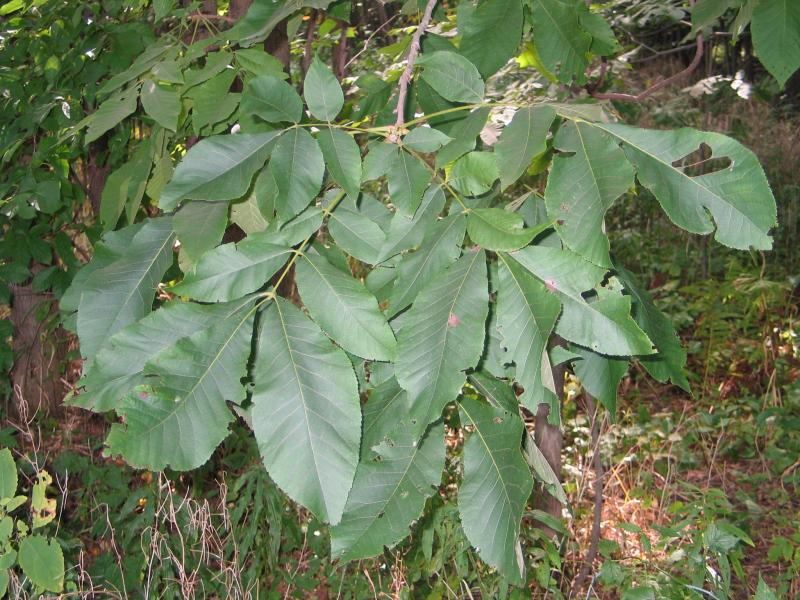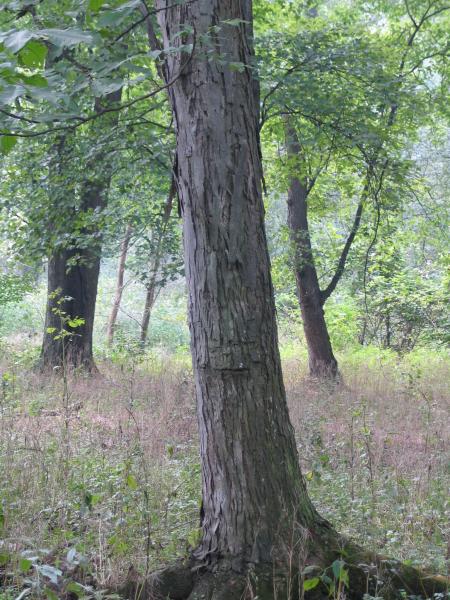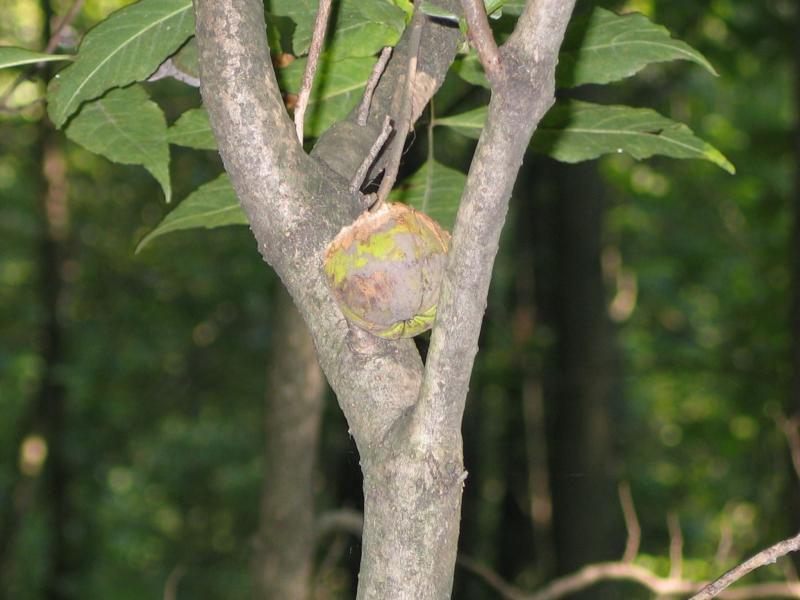Big Shellbark Hickory
Carya laciniosa (Michx. f.) G. Don
- Class
- Dicotyledoneae (Dicots)
- Family
- Juglandaceae (Walnut Family)
- State Protection
- Threatened
Listed as Threatened by New York State: likely to become Endangered in the foreseeable future. For animals, taking, importation, transportation, or possession is prohibited, except under license or permit. For plants, removal or damage without the consent of the landowner is prohibited.
- Federal Protection
- Not Listed
- State Conservation Status Rank
- S3
Vulnerable in New York - Vulnerable to disappearing from New York due to rarity or other factors (but not currently imperiled); typically 21 to 80 populations or locations in New York, few individuals, restricted range, few remaining acres (or miles of stream), and/or recent and widespread declines.
- Global Conservation Status Rank
- G5
Secure globally - Common in the world; widespread and abundant (but may be rare in some parts of its range).
Summary
Did you know?
The edible nuts of the big shellbark hickory are the largest of any hickory. They are valuable food for many wild mammals, ducks, quail and turkeys. The nuts can be collected and eaten raw or used in desserts.
State Ranking Justification
There are at least 30 known populations and seven historical populations. More survey work is needed to determine how many of these historical populations are still present. The populations range in size from a few trees up to 500+ trees. This tree is at its eastern and northern range limits in New York. It very likely has always been an uncommon member of the New York flora.
Short-term Trends
Many new occurrences have been found in the last 20 years and six of the 12 historical records have been relocated.
Long-term Trends
Recent work by Erik Danielsen and Aaron Heminway in Western NY revealed more extant populations than previously known; This may reflect increased survey effort rather than actual increase, however the species does not appear to be in decline as previously thought.
Conservation and Management
Threats
As a floodplain tree, some populations were likely lost or severely reduced as these floodplains were converted to agricultural lands or subjected to permanent flooding through dam creations. Today, this is not as much of a threat. Some of the larger trees may be subject to timber activites, but selective cutting should allow young individuals to remain and maintain species recruitment. Dense coverage of aggressive non-native plants within the floodplain could limit recruitment.
Conservation Strategies and Management Practices
A forest buffer should be provided along the floodplains where these trees occur. Natural flooding regimes should be maintained.
Research Needs
There are no known research needs at this time.
Habitat
Habitat
A tree typically found in the rich alluvium of floodplains, but also in rich mesic soil along riverbanks and marshes. In some areas it can form pure stands, but usually is mixed with other floodplain species (New York Natural Heritage Program 2005). Moist, rich bottomlands and floodplains (Rhoads and Block 2000). Rich bottomlands, along creeks, and in open cedar glades (Flora of North America 1997). Flood plains (Gleason and Cronquist 1991). Riverbanks and rich floodplain woods (Voss 1985). Rich woods and bottoms (Fernald 1970).
Associated Ecological Communities
- Beech-maple mesic forest
(guide)
A hardwood forest with sugar maple and American beech codominant. This is a broadly defined community type with several variants. These forests occur on moist, well-drained, usually acid soils. Common associates are yellow birch, white ash, hop hornbeam, and red maple.
- Floodplain forest
(guide)
A hardwood forest that occurs on mineral soils on low terraces of river floodplains and river deltas. These sites are characterized by their flood regime; low areas are annually flooded in spring, and high areas are flooded irregularly.
- Silver maple-ash swamp
(guide)
A hardwood basin swamp that typically occurs in poorly-drained depressions or along the borders of large lakes, and less frequently in poorly drained soils along rivers. These sites are characterized by uniformly wet conditions with minimal seasonal fluctuations in water levels. The dominant trees are usually silver maple and green ash.
Associated Species
- Acer nigrum (black maple)
- Acer rubrum var. rubrum (common red maple)
- Acer saccharinum (silver maple)
- Acer x freemanii
- Carya cordiformis (bitternut hickory)
- Collinsonia canadensis (stoneroot, horse-balm)
- Erythronium americanum
- Eupatorium rugosum
- Fagus grandifolia (American beech)
- Fraxinus pennsylvanica (green ash)
- Lindera benzoin (spicebush)
- Lysimachia ciliata (fringed-loosestrife)
- Matteuccia struthiopteris
- Onoclea sensibilis (sensitive fern)
- Parthenocissus quinquefolia (Virginia-creeper)
- Quercus bicolor (swamp white oak)
- Quercus macrocarpa (bur oak)
- Quercus rubra (northern red oak)
- Staphylea trifolia (bladdernut)
- Tilia americana var. americana (American basswood)
- Ulmus rubra (slippery elm)
Range
New York State Distribution
This wetland tree has a discontinuous distribution across the state. Most of our populations are within the glaciated areas of central and western New York, but it is also found near the coast in southeastern New York.
Global Distribution
The tree ranges from New York west through southern Ontario, southern Michigan, and southeastern Nebraska, south to eastern Kansas, eastern Oklahoma, Mississippi, Alabama, northern Georgia, and northern North Carolina. It is also planted within and outside of this native range.
Identification Comments
General Description
Big shellbark hickory can grow to be a large tree more than 100 feet tall. The trunk is usually straight and free of branches in the lower half. The crown is oblong to rounded. The bark is light to dark gray and peels off in long shaggy strips like shagbark hickory. The twigs are stout, orange-brown, and have large, dark brown, hairy, winter buds that turn yellow in the spring. The leaves are alternate and compound with seven leaflets but sometimes have as few as five or up to nine leaflets. The three leaflets at the end are larger than the ones below. The edges of the leaves are toothed and without hairs at the tip of the teeth. The male flowers are on long, stalked, dangling catkins in clusters of three. There are 2-5 female flowers on short stalks at the ends of the new branches. These flowers produce the large, rounded, brownish yellow fruits up to 2 1/4 inches in diameter which are usually flattened at the top. The husk easily splits open to reveal a hard, round, flattened nut that is pointed at both ends and up to 2 inches long. The shell is very hard and thick and the kernel is sweet.
Identifying Characteristics
Carya laciniosa has larger fruits than the other hickories, with nuts typically 3-6 cm long. This tree may grow to more than 40 meters tall. The shaggy light gray bark separates into large, thick, broad plates. The first year branchlets are orange-brown to light tan, and often hairy but these hairs fall off with age. The large buds have glabrous scales. There are 7-9 leaflets that are 10-25 cm long and 7-13 cm wide. These leaflets have an acuminate leaf tip and are covered with soft hairs on the underside. The tips of the leaf teeth do not have dense tufts of hair. The nut is 4-6 angled and 3-6 cm long, with a yellowish-brown to reddish-brown shell. The nut is edible.
Best Life Stage for Proper Identification
The key to identifying this species is by collecting the nuts. There should be old nuts on the ground throughout the year. A habitat description will also be very helpful.
Similar Species
Most hickory trees have nuts that range in size from 1-3 cm, compared to the 3-6 cm size found on big shellbark hickory. Many of the other New York hickories are more of an upland tree. You might encounter Carya ovata and Carya cordiformis on a floodplain but only Carya ovata has shaggy bark. Carya cordiformis has thin flat bark with fissures and a distinctive sulfur bud. Its nuts are thin shelled and bitter. Carya ovata has 5-7 leaflets that are glabrous underneath or only with a few scattered hairs. The margins have numerous hairs however. Its nuts are thin shelled and sweet. Carya tomentosa also has large buds and 7-9 leaflets, but it is typically restricted to upland sites, has a more rounded fruit, and the nuts are smaller (1.5-3 cm). It also lacks shaggy bark.
Best Time to See
This tree is obviously visible year-round, but the leaves begin to emerge mid-May and persist until mid-fall. The flowers appear mid-May to early June and fruits develop shortly afterward. Mature fruit are probably not present until early August, but these persist on the trees until a few hard frosts. Fruit from previous years will likely be scattered on the ground and located just below the leaf litter. Surveys may be conducted at any point during the growing season.
- Vegetative
- Flowering
- Fruiting
The time of year you would expect to find Big Shellbark Hickory vegetative, flowering, and fruiting in New York.
Big Shellbark Hickory Images
Taxonomy
Big Shellbark Hickory
Carya laciniosa (Michx. f.) G. Don
- Kingdom Plantae
- Phylum Anthophyta
- Class Dicotyledoneae
(Dicots)
- Order Juglandales
- Family Juglandaceae (Walnut Family)
- Order Juglandales
- Class Dicotyledoneae
(Dicots)
- Phylum Anthophyta
Additional Common Names
- Big Shellbark
- Kingnut Hickory
- Shellbark Hickory
Synonyms
- Hicoria laciniosa (F. Michx.) Sarg.
- Juglans laciniosa F. Michx.
Additional Resources
Best Identification Reference
Gleason, Henry A. and A. Cronquist. 1991. Manual of Vascular Plants of Northeastern United States and Adjacent Canada. The New York Botanical Garden, Bronx, New York. 910 pp.
Other References
Elias, Thomas S. 1980. The Complete Trees of North America Field Guide and Natural History. Van Nostrand Reinhold Co., New York, New York. 948 p.
Fernald, M.L. 1950. Gray's manual of botany. 8th edition. D. Van Nostrand, New York. 1632 pp.
Flora of North America Editorial Committee. 1997. Flora of North America, North of Mexico. Volume 3. Magnoliophyta: Magnoliidae and Hamamelidae.
Holmgren, Noel. 1998. The Illustrated Companion to Gleason and Cronquist's Manual. Illustrations of the Vascular Plants of Northeastern United States and Adjacent Canada. The New York Botanical Garden, Bronx, New York.
Little, E.L., Jr. 1979. Checklist of United States trees (native and naturalized). Agriculture Handbook No. 541. U.S. Forest Service, Washington, D.C. 375 pp.
Mitchell, Richard S. and Gordon C. Tucker. 1997. Revised Checklist of New York State Plants. Contributions to a Flora of New York State. Checklist IV. Bulletin No. 490. New York State Museum. Albany, NY. 400 pp.
New York Natural Heritage Program. 2010. Biotics database. New York Natural Heritage Program. New York State Department of Environmental Conservation. Albany, NY.
New York Natural Heritage Program. 2024. New York Natural Heritage Program Databases. Albany, NY.
Rhoads, Ann F. and Timothy A. Block. 2000. The Plants of Pennsylvania, an Illustrated Manual. University of Pennsylvania Press, Philadelphia, PA.
Rhoads, Ann F. and Timothy A. Block. 2005. Trees of Pennsylvania. A Complete Reference Guide. University of Pennsylvania Press, Philadelphia, PA.
Voss, E.G. 1985. Michigan Flora. Part II. Dicots (Saururaceae - Cornaceae). Cranbrook Institute of Science and University of Michigan Herbarium. Ann Arbor, Michigan. 724 pp.
Weldy, T. and D. Werier. 2010. New York flora atlas. [S.M. Landry, K.N. Campbell, and L.D. Mabe (original application development), Florida Center for Community Design and Research http://www.fccdr.usf.edu/. University of South Florida http://www.usf.edu/]. New York Flora Association http://newyork.plantatlas.usf.edu/, Albany, New York
Links
About This Guide
Information for this guide was last updated on: January 26, 2009
Please cite this page as:
New York Natural Heritage Program. 2024.
Online Conservation Guide for
Carya laciniosa.
Available from: https://guides.nynhp.org/big-shellbark-hickory/.
Accessed July 26, 2024.


